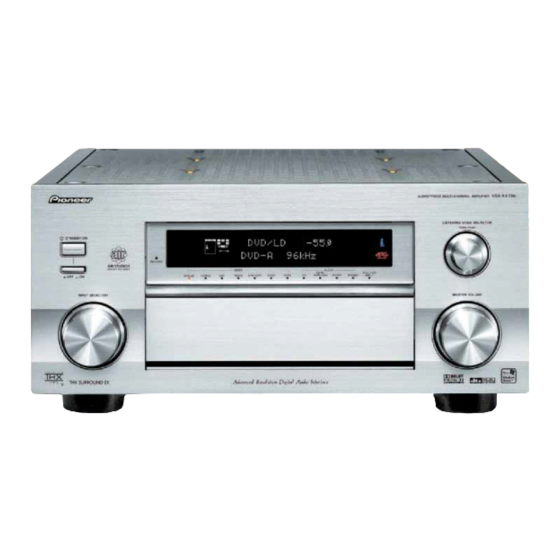Pioneer VSA-AX10Ai-S Broschüre & Specs - Seite 7
Blättern Sie online oder laden Sie pdf Broschüre & Specs für Verstärken Pioneer VSA-AX10Ai-S herunter. Pioneer VSA-AX10Ai-S 12 Seiten. Multi-channel stereophonic amplifier
Auch für Pioneer VSA-AX10Ai-S: Benutzerhandbuch (47 seiten)

making it possible to achieve measurements even closer to the direct sound. The
calibration timing is variable in 0 – 160 ms, whereas timing is fixed for the calibration
technology used so far. The timing is automatically set by Pioneer's original
algorithm or manually, if preferred.
You can see the reverberation characteristics either on-
screen (OSD) in a simple 2-D image or even a 3-D colour
graphic image on PC displays, by connecting a RS-232C
RS-232C terminal on back
panel
cable (not included) to your PC, and downloading
s o f t w a r e
from the Pioneer website. This is a
useful tool to visualise proper settings
for your specific environment.
Example of a room with no reverberation — nonexistent in a
Precise Speaker Setting Alignment
The VSA-AX10Ai-S includes an additional tool, a
Reference Calibration Disc (included with the
amplifier), to calibrate the physical speaker
positions even more precisely. This special
DVD-Video disc contains two types of signals in
DTS format: one for fine speaker distance
adjustment and one for fine speaker angle
adjustment.
For
fine
adjustment, the speakers' distance can be set
with an accuracy of less than 1 cm by listening to
the unique test tone, and then, taking the Front
Reference Calibration Disc
Left speaker as the reference speaker, moving the
others speakers in turn so that the test tone
emanates from exactly in between them. For fine speaker angle adjustment, a voice moves around the listening position in 30° steps — like the arms of
a clock —, so the speaker angle can be adjusted to the ideal direction envisioned by the sound designer (ITU-R speaker setting standard used for multi-
channel music monitoring). These two adjustments work perfectly with MCACC for the best possible sound stage in a room.
Advantage in Calibration Points with Advanced MCACC
63.0
62.0
61.0
60.0
59.0
58.0
57.0
56.0
55.0
54.0
53.0
0 10
20
30
40
Boundary of measurement and calibration points with standard MCACC: 80 – 160 ms
Boundary of measurement with Advanced MCACC: 0 – 160 ms
Boundary of automatic calibration points with Advanced MCACC: automatically selected from
20 – 40 ms and 60 – 80 ms
Boundary of manual calibration points: manually selected from within the Advanced MCACC
measurement boundary of 20 – 80 ms (20 ms frames with 10 ms steps). For the 80 – 160 ms range,
standard MCACC will be applied.
Example of a room with a large amount of reverberation
home environment
C
FL
FR
speaker
distance
LS
RS
Fine adjustment of speaker distance
50
60
70
80
90
100 110 120 130
140 150 160
Time (ms)
'X-curve' adjustment*: automatic correction for room size
Advanced MCACC includes an additional automatic adjustment to ensure that the sound
reproduction is even more perfectly matched to your room — the correction for room size.
What the human ear/brain perceives as a flat frequency response is a subjective
phenomenon dependent on distance between the listener and the sound source; our
perception changes according to the size of the room. High frequencies decrease more for
larger rooms due to the psycho-acoustic effect, according to scientific research. The
VSA-AX10Ai-S automatically compensates for this difference by applying the famous
'X-Curve', according to
room size. 'X-Curve' is
Rotate
widely used in acoustic
designing
Axis of rotation
theatres and dubbing
stages. You will hear the
sound as it should be
Adjust speaker direction
heard.
* X-curve is authorised as an
international standard, ISO 2969.
X-curve Adjustment
for
film
+5 dB
+0 dB
-5 dB
-10 dB
-15 dB
-20 dB
20 Hz
50 Hz
100 Hz 200 Hz
500 Hz
1 kHz
2 kHz
7
5 kHz
10 kHz
20 kHz
